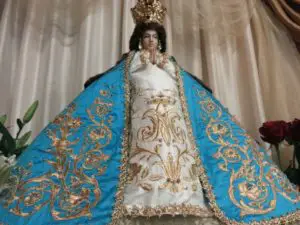In the interest of experiencing as much of Mexican culture as we can, Bob and I attended a bullfight recently at Plaza de Toros “Nuevo Progresso” in Guadalajara.
We had to experience it once. We left after one bullfight.
It started out fun
It started out fun. Upon arrival, outside the stadium, we encountered a carnival of food, drinks and booths selling cowboy hats, candy, hand fans, bullfighter-branded seat cushions, and nieve garrafa (ice cream made in a canister). The building itself resembled a small Roman coliseum, and was decorated with image upon image of famous matadors. There was matador art and metal bull sculptures, balloons and cotton candy and, of course, tequila and cervesas. I saw a young girl in a bright red, traditional ruffled costume. Women wore high heels and white embroidered tops. Men dressed nattily. We were underdressed in our chinos and jeans.
 |
|
The sport’s Spanish origins were evident in a tent outside,
where paella and wine were served by waiters
in an elegant setting before the bullfight started.
|
 |
| Photos of famous matadors were mounted outside on the stadium walls |
Once we got inside, we took our places on the concrete seats with an excellent view of the round stadium. The show began promptly at 4:30 PM with matadors in gaudy, glittery costumes parading around the ring to the blaring bullfighting music that I recognized from the opera “Carmen.” It was festive and colorful.
 |
| The big introduction |
 |
| Prepping the ring like the infield of a baseball game |
 |
| Introducing the bull |
But that’s where the fun ended
This is how the “competition” went down: Five or six matadors essentially ganged up on the poor bull, making a mockery of the majestic animal while the crowd cheered. First they taunted him to get him confused and angry, waving bright pink capes to lure him toward them and then scampering behind barricades.
 |
| It was a dance, as the matador drew the bull closer |
Once they got the bull good and mad, the main matador, a peacock of a man in sparkly gold with a sword and red cape, arrived, posing and preening to roars of the crowd. He then performed a number of moves to trick the bull and make himself look important, pausing to soak in the crowd’s approval. The people all around us cheered every time the bull was tricked. (We were rooting for the bull.)
Next, a rider on a horse in heavily padded protection trotted around the periphery of the ring, raised a long, decorated spear and stabbed the bull in the shoulder, then yelped triumphantly as the crowd screamed, “Ole!” Soon the matadors were also stabbing the bull with smaller decorated sticks, and as the blood streamed down the back of the bull, the crowd again shouted, “Ole!” (I am providing no pictures of this.)
In the end, the chief matador had the “privilege” of slaughtering the bull with a brutal stab of a shiny long sword, and after the cheering was over, the dead bull was dragged away behind two horses.
It was truly repugnant
Bob knew I would have trouble dealing with the blood in this sport, but even he was utterly disgusted. Long before the first fight was over, he told me he was ready to leave. The stadium was only about ten percent full, so obviously Mexicans aren’t that enamored of bullfighting anymore either.
 |
The entire scene
(Note all the empty seats) |
Some Facebook friends have criticized us for attending the bullfight, saying “nice people” wouldn’t condone a blood sport this way and that we were legitimizing it by our presence in the arena. This is my response: If you want to experience a culture and truly understand its people, you need to be open to witnessing their traditions without applying your own preconceived notions. Bullfighting has been going on in Mexico for almost 800 years, and 500 years in Spain before that. Going one time to bear witness is hardly supporting the sport, which would have occurred whether we were there or not. That bull was still going to end up on their dinner table later in the evening.
And walking out after one fight is NOT legitimizing it; quite the opposite. We came, we saw, we left. Then we shared our observations with others to provoke dialogue. If we had cheered for the matador and stayed for the whole thing, bought souvenirs and come back excited to see it again, THAT would supporting the sport.
Bullfighting and football
We asked our Spanish teacher about bullfighting. She said it is the sport of Mexico’s “elite,” and we realized it had, indeed, been a flashy sunglasses and designer shoe crowd in the stadium. Which begs the question: Why does a society’s blue bloods go in for a bloody sport like this? Then again, why do Americans tolerate football and cheer when we know the sport rattles the brains of most of its participants, shortens their lives and batters their bodies? How are we any different, really?
And while we’re on the subject, who are we to say bullfighting is worse than American football? Some would say supporting football is OK because players make the choice to play, knowing the potential consequences, whereas bulls have no choice — they’re bred to be slaughtered in public and humiliating fashion. I don’t know what the answer is. Just putting that out there for thought and discussion.
One thing I do know: This is an experience we will definitely not repeat.
 |
The Selfie of the Day was very somber.
We took the shot and walked out. |



























